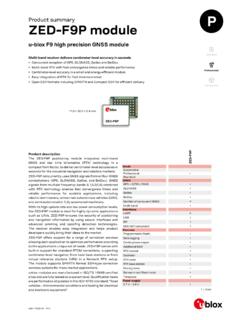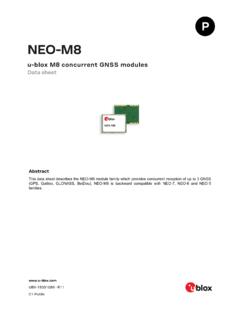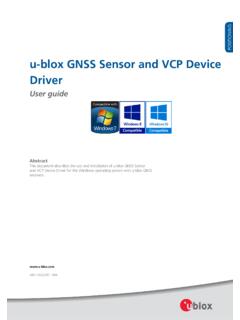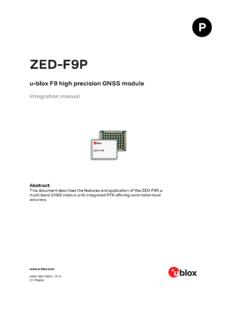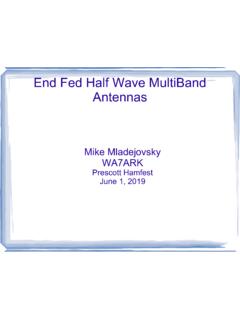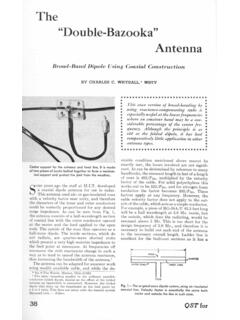Transcription of RF design considerations for u-blox GNSS receivers
1 gnss antennas RF design considerations for u- blox gnss receivers Application note Abstract This document provides an overview of important antenna and interference issues to be considered when integrating u- blox gnss receivers . UBX-15030289 - R03 gnss antennas - Application note UBX-15030289 - R03 Page 2 of 36 Document information Title gnss antennas Subtitle RF design considerations for u- blox gnss receivers Document type Application note Document number UBX-15030289 Revision and date R03 16-Oct-2019 Disclosure restriction This document applies to the following products: Product name All u- blox gnss products u- blox or third parties may hold intellectual property rights in the products, names, logos and designs included in this document.
2 Copying, reproduction, modification or disclosure to third parties of this document or any part thereof is only permitted with the express written permission of u- blox . The information contained herein is provided as is and u- blox assumes no liability for its use. No warranty, either express or implied, is given, including but not limited to, with respect to the accuracy, correctness, reliability and fitness for a particular purpose of the information. This document may be revised by u- blox at any time without notice. For the most recent documents, visit Copyright u- blox AG. gnss antennas - Application note UBX-15030289 - R03 Page 3 of 36 Contents Document information .. 2 Contents .. 3 1 Introduction .. 5 2 antenna basics .. 5 General considerations .
3 5 antenna requirements .. 5 antenna placement .. 6 Active and passive antennas .. 6 3 Passive antenna types .. 8 Patch antenna .. 8 Helix antenna .. 9 Monopole antennas .. 9 Chip antenna .. 9 Fractal Element antenna (FEA) ..12 Dipole antenna ..12 Loop antenna ..13 Planar Inverted F antenna (PIFA) ..14 High-end gnss antennas ..14 4 Which antenna is best for my application? .. 15 Helix or patch? ..15 Other antenna types ..15 5 design considerations .. 16 Patch antennas ..16 Ground plane ..16 Placement ..17 ESD issues ..18 Helix antennas ..18 Ground plane ..19 Placement ..19 antenna matching ..19 GSM applications ..20 Isolation between gnss and GSM antenna ..20 Dual antenna systems ..20 6 Interference issues.
4 23 Sources of noise ..23 Eliminating digital noise sources ..24 Power and ground planes ..24 High-speed signal lines ..25 Decoupling capacitors ..25 Shielding ..26 gnss antennas - Application note UBX-15030289 - R03 Page 4 of 36 Feed through capacitors ..27 Shielding sets of sub-system assembly ..28 Increasing jamming immunity ..29 In-band jamming ..29 Out-band jamming ..30 7 Performance tests .. 31 Sky View ..31 Statistic View ..31 Supply voltage check ..32 Sensitivity test ..32 Startup test ..32 Appendix .. 33 A Example of receiver signal to noise (C/No) performance calculation .. 33 Related documents .. 35 Revision history .. 35 Contact .. 36 gnss antennas - Application note UBX-15030289 - R03 Contents Page 5 of 36 1 Introduction Antennas are a critical part of any gnss receiver design and their importance cannot be stated highly enough.
5 Even the best receiver cannot bring back what has been lost due to a poor antenna , in-band jamming, or a bad RF board design . gnss signals are extremely weak and present unique demands on the antenna . The choice and implementation of the antenna can ultimately play a significant role in gnss performance. This document considers some of the RF and interference issues when implementing a gnss antenna . 2 antenna basics General considerations A gnss receiver needs to receive signals from as many satellites as possible. Optimal performance will not be available in narrow streets and underground parking lots or if objects cover the antenna . Poor visibility may result in position drift or a prolonged Time-To-First-Fix (TTFF). Good sky visibility is therefore an important advantage.
6 A gnss receiver will only achieve the specified performance if the average carrier to noise power density ratio (C/N0) of the strongest satellites reaches at least 44 dBHz. In a well-designed system, the average of the C/N0 ratio of high elevation satellites should be in the range between 44 dBHz and about 50 dBHz. With a standard off-the-shelf active antenna , 47 dBHz should easily be achieved. antenna requirements For optimal performance, use antennas with high gain ( >4 dBic) and active antennas with an LNA with a low noise figure (<2 dB). Ideally, the antenna has: A low level of directivity1 (see Figure 1) Good antenna visibility to the sky Good matching between antenna and cable impedance High gain Filter Figure 1: antenna radiation pattern showing low directivity (left) vs.
7 High directivity (right) Appendix A provides an example of how to estimate the influence of the noise figure (NF) and gain on antenna performance. 1 antenna gain increases with the level of directivity. gnss antennas - Application note UBX-15030289 - R03 Contents Page 6 of 36 antenna placement The position of the antenna mounting is crucial for an optimal performance of the gnss receiver. When using patch antennas, the antenna plane should be parallel to the geographic horizon. The antenna must have full view of the sky ensuring a direct line-of-sight with as many visible satellites as possible. 1st choice placement 2nd choice placement Recommended antenna positions Performance may be degraded!
8 If recommended placements are not available, these may also be viable. Note: Window and roof reduce gnss signal and obstruct sky view2 Note: There may be multipath signals and an obstructed sky view Note: Fiberglass airfoil attenuates the gnss signal Figure 2: Recommended antenna position Place the antenna as far away as possible from radiating or jamming signals. Active and passive antennas Passive antennas contain only the radiating element, the ceramic patch or the helix structure. Sometimes they also contain a passive matching network to match the electrical connection to 50 Ohms impedance. Active antennas have an integrated Low-Noise Amplifier (LNA). This is beneficial 2 Some cars have a metallic coating on the windscreens.
9 GPS/GALILEO reception may not be possible in such a car without the use of SuperSense Technology. There is usually a small section, typically behind the rear view mirror, reserved for mobile phone and GPS/GALILEO antennas. gnss antennas - Application note UBX-15030289 - R03 Contents Page 7 of 36 in two respects. First, the losses of the cable after the LNA no longer affect the overall noise figure of the gnss receiver system. Secondly, the LNA in the antenna helps to reduce the overall noise figure of the system resulting in a better sensitivity. Some receivers are designed so that they will only work with active antennas. Active antennas need a power supply that will contribute to gnss system power consumption, typically in the order of 3 to 20 mA.
10 Usually, the supply voltage is fed to the antenna through the coaxial RF cable. Inside the antenna , the DC component on the inner conductor will be separated from the RF signal and routed to the supply pin of the LNA. The use of an active antenna is always advisable if the RF cable length between the receiver and antenna exceeds about 10 cm. Care should be taken that the gain of the LNA inside the antenna does not lead to an overload condition at the receiver. For receivers that also work with passive antennas an antenna LNA gain of 15 dB is usually sufficient, even for cable lengths up to 5 m. There is no need for the antenna LNA gain to exceed 26 dB for use with u- blox receivers (at the RF input). With shorter cables and a gain above 35 dB, an overload condition might occur on some receivers .



